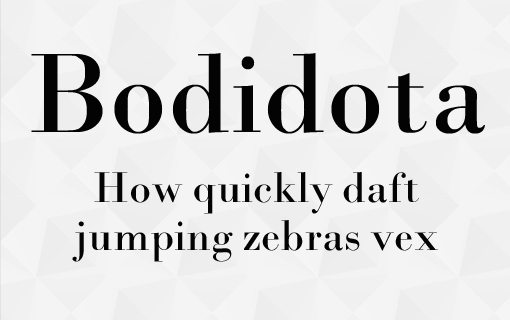

Their vertical axis coupled with strong horizontal stress furnishes them with the stiffness of toy soldiers on parade.

There’s something rather clinical about the Moderns, especially in the roman capitals. Though both forms share a common vertical (rationalist) axis, the Moderns have even greater contrast. Whereas the Old Style types are Neoclassical, the Didones are Romantic. The romans of the Modern types owe very little, if anything to the earlier calligraphic forms they are too precise, too sharp, too clean. If you’ve read the preceding three installments, then you will have noticed a move away from the Humanist or handwritten letterforms. In fact, if you grab a Baskerville, take away the brackets that join serifs to stems, thicken up the vertical strokes, you’ll be left with something that resembles a Didone (though don’t expect it to be pretty).

Abrupt (unbracketed) hairline (thin) serifs

High and abrupt contrast between thick and thin strokes Ģ. The second volume includes numerous ornaments, Arabic, Greek, Russian, and Tibetan types, to name but a few. However, Bodoni was a prolific type designer, completing hundreds of typefaces the Museo Bodoniano in Parma, houses more than 25,000 of his punches! Bodoni’s Manuale Tipografico¹ (1818) contains 142 roman typefaces and their corresponding italics-and that’s just volume one. The Italian type designer, punchcutter and printer Giambattista Bodoni (what a great name! ) drew his influence from the Romains du Roi (with its flat, unbracketed serifs) and the types of John Baskerville (high contrast), for whom he showed great admiration.īodoni will forever be associated with the hordes of digital interpretations from just about every type foundry on earth-the FontBook devotes some 14 pages to flavors of Bodoni some are faithful digital renderings, others well-crafted interpretations while others still are nothing but parodies, suitable only for poster headlines or the typographic scrap-heap. His types were soon followed by the archetypal Didone from Bodoni. The first Modern typeface is attributed to Frenchman Firmin Didot (son of François-Ambroise Didot), and first graced the printed page in 1784. So, making fonts empire website as a bookmark in your browser will be helpful for finding us again.In the previous installment of this series, we took a closer look at Transitional style typefaces, so-called because they mark a transition from the former Old Style types-epitomized by Baskerville-and the subject of today’s brief history, the Moderns, also known as Didone (the terms Modern and Didone are used synonymously throughout this article).īaskerville’s types, compared with their Old Style (or Garalde) predecessors, are marked by high contrast between thick and thin strokes, so much so that one commentator declared Baskerville was “blinding the nation.” The Moderns or Didones take this contrast to further extremes (just about as far as one can take them). Moreover, tell us your feedback about it in the comment section and also suggest us for some improvements for this website.
#DIDOT TYPEFACE FREE#
If you like this free font then make sure to share it with your friends and colleagues at your social networks. So developing a whole new website template along with it is also a rational idea. Didot family will also help you in making different kinds of websites template textual content. The file below includes many Didot family font that is appropriate for any relevant place you want.īut before downloading this sans-serif fonts have a look at the images we attached to see how your font will look like. Let me welcome you! with a simple single click at the downloadable file. You might be a designer or a developer looking forward to this unique and cool font family and landed here. This font family will spread a unique and well-kept impression to any place where there is a kind of textual content occupancy. Such as composing logos, wedding cards designing, invitation cards designing, brochure layout, book covers composing, elegant banners and flex designing, t-shirt textual printing and many other places. Many designers are using this font for there regular undertakings. You must have seen the fonts from Didot family many times in your life as these are regular using typefaces all the times. Most of the popular Didot fonts were produced in 1784–1811 Firmin Didot and printed by his brother Pierre Didot.Īll the typeface that are including in this family has their definite personal and sole glimpses. These typefaces are named after the famous French publication and type composing Didot family. Introducing Didot, The group of prominent typefaces introduced by Linotype.


 0 kommentar(er)
0 kommentar(er)
